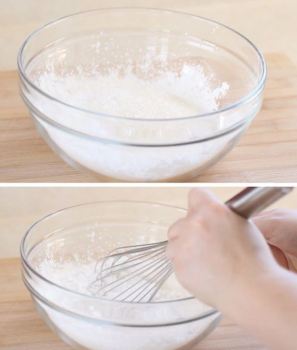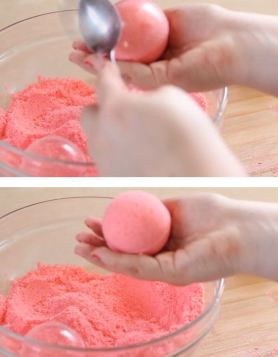Make a thoughtful, handmade Mother’s Day gift this year with the perfect gift for the mum who loves to relax… From DIY soap, bath bombs & candles, you can’t go wrong!
DIY BATH BOMBS
YOU WILL NEED:
- 1 cup Sodium Hydrogen Carbonate
- 1/2 cup Citric Acid
- 1/2 cup Epsom Salts
- 1 tsp. Water
- 2 tsp. essential oil
- 3 tsp. oil (olive oil)
- Food colouring (any colour)
- Bowl
- Whisk
- Jar
- Spoon
- Bath Bomb mould
STEP 1
Place the Sodium Hydrogen Carbonate , Citric Acid and Epsom Salts in a bowl and mix with whisk.

STEP 2
In the jar, mix together using a small spoon the water, essential oil, olive oil and food colouring. This is an important step and where you can get creative so make sure to try out some fragrance oils to find your favourite combination!
STEP 3
Slowly add the liquid mixture to the dry mixture, one small spoon at a time.
STEP 4
When mixed, pack the mixture into a bath bomb mould and pack tightly, then let it dry. Be as quick as you can to avoid the bath bomb mixture drying out! Let this dry for 24 hours to ensure the mixture doesn’t move. Once done, take out of mould and place in a small box ready to give as a mother’s day present!

DIY SOAP
Give the perfect gift this Mother’s Day with a handmade soap perfect for using daily, this gift will be an unforgettably thoughtful!
YOU WILL NEED:
- Two good sized stainless steel or enamelled saucepans.
- One heat-proof glass measuring jug or plastic jug able to withstand boiling water.
- Accurate kitchen scales.
- Utensils for stirring for example Wooden or stainless steel spoons or similar.
- Two cooking/brewing thermometers
- A mould to pour the liquid soap into whilst it sets. A wooden or cardboard tray or box lined with grease-proof paper.
- Eye and hand protection (safety glasses and rubber gloves).
- A blanket or large towel.
- 12 oz. (340g) of cold, clean water
- 125g of Sodium Hydroxide Pearl 99%
- 1lb (454g) olive oil (virgin or extra virgin will do)
- 10oz. (284g) coconut oil
- 6oz. (170g) palm oil
- 1/4 tsp. Grapefruit seed extract OR Vitamin E
STEP 1
Make sure all protective gear is being worn and plan to make soap when you won’t be interrupted. Please Note – Make sure Children and Pets aren’t in the general area. Make sure to have a Water Source nearby in case you need to wash off any spills. Make sure you have all the ingredients and equipment listed above BEFORE you start and weigh them out into suitable containers ready to use. First choose your mould. If choosing lined wooden mould, make sure the lining paper is not cut or holed in any way below the top of the mould. It must be folded into corners to ensure there are no leaks.
STEP 2
Measure out 12 oz. (340g) of cold clean water into a jug. Weigh (accurately) 125g of Sodium Hydroxide Pearl into a suitable container. Carefully add the sodium hydroxide to the water, stirring all the time with a spoon or spatula. Please Note – Be careful not to breathe the vapour that is initially given off, Wear a mask and stir until all the Sodium Hydroxide has dissolved and there are no lumps stuck to the bottom of the jug. The solution (now known as Lye) will heat up to nearly 200 degrees Celsius and will need to be left to cool. Place one of the thermometers into the solution and leave to one-side.
STEP 3
Meanwhile, measure out exactly 10oz. (284g) of coconut oil and 6oz. (170g) of palm oil into one of the saucepans and gently melt it on the stove. Don’t overheat it, just melt it. When there are tiny pieces of solid oil still left to melt, turn off the heat and leave until completely liquid. If using a Pigment to colour your soap, add a little to the warm oils now. Whilst the solid oils are melting, measure out 1lb (454g) of olive oil into the other saucepan (this will be the soap-making pan). Once melted, pour the combined coconut and palm oils into the olive oil and mix them all together. Place the other thermometer in the pan of oils. You should end up with a thermometer in each of the lye and oils.
STEP 4
What you now need to do is keep watch on the temperatures of both the oils and the Sodium Hydroxide solution (Lye). Once both oils and lye are at near similar temperatures they can be combined. As a guide a minimum of around 80 degrees Celsius and a maximum of around 130 degrees Celsius are ideal limits of temperature. As long as oils and lye are both at similar temperatures between these limits.
STEP 5
When at the correct temperatures, slowly and carefully pour the lye into the oils, and start stirring (preferably with a hand balloon) whisk to ensure the mixture all starts to chemically react and combine. You should stir throughout the mixture fairly briskly. You will notice the solution start to turn more opaque and as the minutes pass it will start to thicken. The stage in the process you have to wait for is known as the ‘Trace’. If adding essential oil/s, add them at ‘the trace’ after any colour and stir in well. Once everything is added and the mixture traces simply pour it into your lined mould.
STEP 6
Cover the mould with something like a cardboard sheet to prevent anything touching the surface of the soap whilst it’s setting. Insulate with old towels or a blanket and leave at room temperature until the soap has solidified. With a small batch like this example, this should be no more than 24 hours.
STEP 7
Once set and cool, remove the soap from the mould and remove any lining paper from the soap. At this stage it will be a soft solid and can be easily cut into bars or smaller blocks if desired. If it appears too soft to handle, leave it for 2-3 days and try again. Leave your soap ‘curing’ at room temperature for typically at least 3-4 weeks, preferably on a sheet of uncoloured absorbent paper allowing air to circulate around each bar or block.
DIY CANDLES
The perfect gift for the mum who wants to relax…
YOU WILL NEED:
Wicks (If following this guide, you will want to look at a large wick)
Fragrance Oils
Double Boiler
Containers (Anything that can withstand heat can be used as a container)
Thermometer
Spatula
STEP 1
Start by preparing the work area as dealing with wax is rather messy. Set up newspaper or paper towels around your work area and set your spatula, thermometer, etc. Have your containers and wicks at the ready as the process is very quick. Adhere the wick to the container. As the wax starts melting, it’ll form a pool of liquid. Dip the metal tab of the wick into that melted wax, then quickly adhere it to the bottom of the container. After a couple of minutes, the wax will harden and it will be stuck to the bottom. Alternatively, use adhesive pads. To secure the wick, add for example a closed peg to centre the wick resting on top of your container.
STEP 2
Using your double boiler, melt the wax. Put a good amount of water in the bottom pan then add about half a pound of wax in the double boiler (this will make the perfect amount to fit in an 8oz. mason jar). The wax will then begin to melt, stir and break up the big chunks with the spatula. It only takes 10-15 minutes for the wax to melt but make sure to keep an eye on the temperature. The temperature should be around 85 to 95 degrees Celsius. If the temperature gets high, take it off the heat.
STEP 3
Let it cool for a couple minutes. We advise pouring the wax into the container between 75 to 85 degrees Celsius however this is just a guide. This doesn’t take long so pay attention to your thermometer. *THESE TEMPERATURES ARE JUST A GUIDELINE*
Once the wax is cooled, go ahead with your first pour into the container. As the paraffin wax cools it shrinks in size, therefore you will be required to do a second pour to fill the container to your required level.
STEP 4
Pour the amount of fragrance you require into your double boiler and stir for 30 seconds or so to ensure it’s evenly distributed. As the paraffin wax cools it shrinks in size, you will notice a small sinkhole in the middle, the wax will also be pulling away from the edges of the jar therefore you will need a second pour, topping it off cures these problems. Re-heat the wax that you left in the boiler and top up the candle. Don’t add too much, or you may end up with another hole.
STEP 5
You may have a few inches of wick sticking up from your candle. You should trim this down to just about 5mm. (A wick that is too long will burn too big and hot). Now time to clean up the wax. There will be some in the boiler, on your tools and maybe on your kitchen sides. The best way to clean it is to wipe the wax away with a paper towel while it’s still in liquid form. *PLEASE NOTE: DO NOT RINSE IT DOWN THE DRAIN OR PUT TOOLS IN THE DISHWASHER AS IT CAN CLOG UP YOUR PIPES*. Simply use a paper towel or other disposable rags! Don’t panic if the wax does harden as it will scrape off.
Allow the candle to sit for 24-48 hours. Your candle is now ready to gift!
NOTE: BEFORE USING ANY OF THE PRODUCTS LISTED PLEASE READ ANY SAFETY AND PRECAUTIONS TO THIS PRODUCT BEFORE USAGE.
PLEASE ALSO COMPLETE A PATCH TEST.
APC Pure does not accept any responsibility, this is a guide only.
